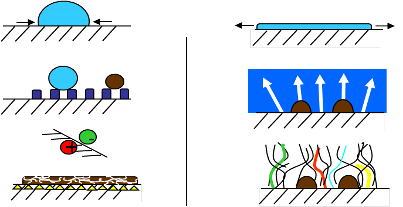My Projects
Topic: Self-Cleaning Effects
Title: Dirt Repellent Surfaces

The scheme illustrates different effects for apparently clean surfaces:
Left side from above: Dirt repellent by low adhesion (hydrophobicity) or low contact area (Lotus effect) …
… or high conductivity (antistatic) or reactive surfaces (e.g. vibration or photolysis).
Right side from above: Dirt masking by high adhesion (hydrophilicity) or gloss (outshine) …
… or embedment (e.g. shagreen or tuft).
What one doesn’t see:
“Dirt is matter at a wrong place!” This definition by the Nobel laureate Philipp Lenard 1905 captures best the meaning of dirt. In this sense cleaning means to assign the dirt matter a “right” place. Actually, this depends on the requests: If just invisibility is required, then a masking will be appropriate. However, if a removal of contaminants is required, it should be better visible. In fact, premium class surfaces are mostly rather “sensible” – i.e. they easily become polluted – whereas robust surfaces often apply to be “gross” – i.e. they are suspected to be polluted. That is why surface technology seem to follow temporary fashions.
What’s behind it:
The design of a clean or dirt-repellent surface requires first of all an investigation about the real request of the customer or user. Only afterwards a technical solution can be established to fulfill these desires.
What you con obtain from it:
A typical technical solution is based on a suitable combination of different effects – for instance, the deep tuft of a carpet with a hydrophobic coating, or a high gloss with a Lotus effect.
For sure, the steady pollution by environmental impacts can never be avoided, but just rearranged in a more appropriate manner, such as suitable bonding at prepared dirt traps.
My related publications:
Bright Coatings for Aluminum or Steel Motor Vehicle Wheels and Their Production, patent US 20100021757 A1 (2010)
Heat Exchanger, Preferably Condenser-Cooled of Air-Conditioner, with an Antifouling-Coating Containing Tetraeder Lipid Derivative on Ist Surface, German patent DE10 2006 03 8543 (2006)